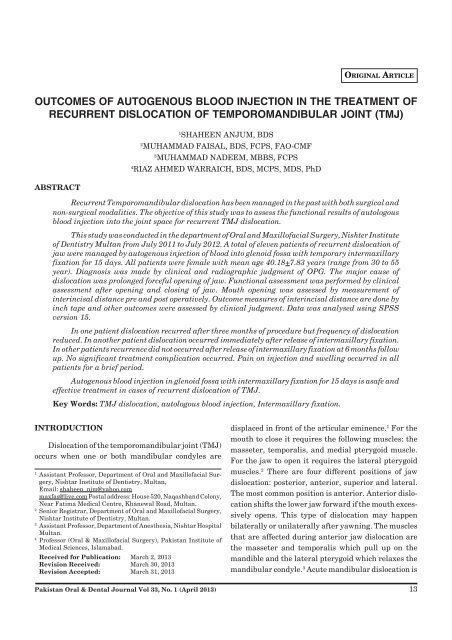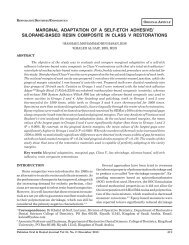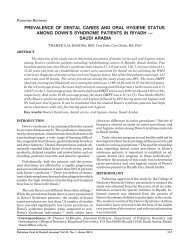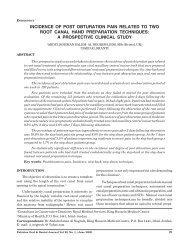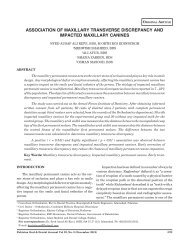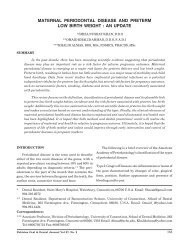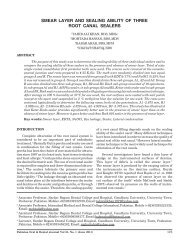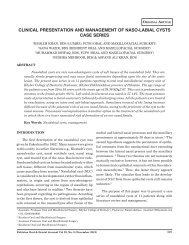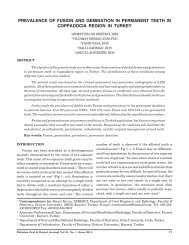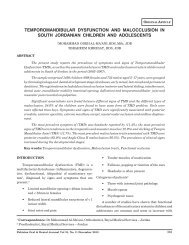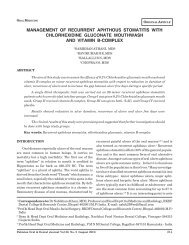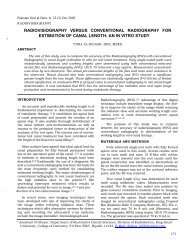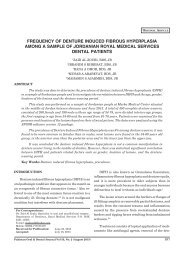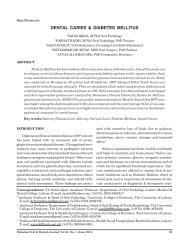outcomes of autogenous blood injection in the treatment of recurrent ...
outcomes of autogenous blood injection in the treatment of recurrent ...
outcomes of autogenous blood injection in the treatment of recurrent ...
Create successful ePaper yourself
Turn your PDF publications into a flip-book with our unique Google optimized e-Paper software.
Outcomes <strong>of</strong> <strong>autogenous</strong> <strong>blood</strong> <strong><strong>in</strong>jection</strong> <strong>in</strong> <strong>the</strong> <strong>treatment</strong> <strong>of</strong> TMJ<br />
ORIGINAL ARTICLE<br />
OUTCOMES OF AUTOGENOUS BLOOD INJECTION IN THE TREATMENT OF<br />
RECURRENT DISLOCATION OF TEMPOROMANDIBULAR JOINT (TMJ)<br />
1<br />
SHAHEEN ANJUM, BDS<br />
2<br />
MUHAMMAD FAISAL, BDS, FCPS, FAO-CMF<br />
3<br />
MUHAMMAD NADEEM, MBBS, FCPS<br />
4<br />
RIAZ AHMED WARRAICH, BDS, MCPS, MDS, PhD<br />
ABSTRACT<br />
Recurrent Temporomandibular dislocation has been managed <strong>in</strong> <strong>the</strong> past with both surgical and<br />
non-surgical modalities. The objective <strong>of</strong> this study was to assess <strong>the</strong> functional results <strong>of</strong> autologous<br />
<strong>blood</strong> <strong><strong>in</strong>jection</strong> <strong>in</strong>to <strong>the</strong> jo<strong>in</strong>t space for <strong>recurrent</strong> TMJ dislocation.<br />
This study was conducted <strong>in</strong> <strong>the</strong> department <strong>of</strong> Oral and Maxill<strong>of</strong>acial Surgery, Nishter Institute<br />
<strong>of</strong> Dentistry Multan from July 2011 to July 2012. A total <strong>of</strong> eleven patients <strong>of</strong> <strong>recurrent</strong> dislocation <strong>of</strong><br />
jaw were managed by <strong>autogenous</strong> <strong><strong>in</strong>jection</strong> <strong>of</strong> <strong>blood</strong> <strong>in</strong>to glenoid fossa with temporary <strong>in</strong>termaxillary<br />
fixation for 15 days. All patients were female with mean age 40.18+7.83 years (range from 30 to 55<br />
year). Diagnosis was made by cl<strong>in</strong>ical and radiographic judgment <strong>of</strong> OPG. The major cause <strong>of</strong><br />
dislocation was prolonged forceful open<strong>in</strong>g <strong>of</strong> jaw. Functional assessment was performed by cl<strong>in</strong>ical<br />
assessment after open<strong>in</strong>g and clos<strong>in</strong>g <strong>of</strong> jaw. Mouth open<strong>in</strong>g was assessed by measurement <strong>of</strong><br />
<strong>in</strong>ter<strong>in</strong>cisal distance pre and post operatively. Outcome measures <strong>of</strong> <strong>in</strong>ter<strong>in</strong>cisal distance are done by<br />
<strong>in</strong>ch tape and o<strong>the</strong>r <strong>outcomes</strong> were assessed by cl<strong>in</strong>ical judgment. Data was analysed us<strong>in</strong>g SPSS<br />
version 15.<br />
In one patient dislocation recurred after three months <strong>of</strong> procedure but frequency <strong>of</strong> dislocation<br />
reduced. In ano<strong>the</strong>r patient dislocation occurred immediately after release <strong>of</strong> <strong>in</strong>termaxillary fixation.<br />
In o<strong>the</strong>r patients recurrence did not occurred after release <strong>of</strong> <strong>in</strong>termaxillary fixation at 6 months follow<br />
up. No significant <strong>treatment</strong> complication occurred. Pa<strong>in</strong> on <strong><strong>in</strong>jection</strong> and swell<strong>in</strong>g occurred <strong>in</strong> all<br />
patients for a brief period.<br />
Autogenous <strong>blood</strong> <strong><strong>in</strong>jection</strong> <strong>in</strong> glenoid fossa with <strong>in</strong>termaxillary fixation for 15 days is asafe and<br />
effective <strong>treatment</strong> <strong>in</strong> cases <strong>of</strong> <strong>recurrent</strong> dislocation <strong>of</strong> TMJ.<br />
Key Words: TMJ dislocation, autologous <strong>blood</strong> <strong><strong>in</strong>jection</strong>, Intermaxillary fixation.<br />
INTRODUCTION<br />
Dislocation <strong>of</strong> <strong>the</strong> temporomandibular jo<strong>in</strong>t (TMJ)<br />
occurs when one or both mandibular condyles are<br />
1<br />
Assistant Pr<strong>of</strong>essor, Department <strong>of</strong> Oral and Maxill<strong>of</strong>acial Surgery,<br />
Nishtar Institute <strong>of</strong> Dentistry, Multan,<br />
Email: shaheen_njm@yahoo.com<br />
maxfas@live.com Postal address: House 520, Naqashband Colony,<br />
Near Fatima Medical Centre, Khanewal Road, Multan.<br />
2<br />
Senior Registrar, Department <strong>of</strong> Oral and Maxill<strong>of</strong>acial Surgery,<br />
Nishtar Institute <strong>of</strong> Dentistry, Multan.<br />
3<br />
Assistant Pr<strong>of</strong>essor, Department <strong>of</strong> Anes<strong>the</strong>sia, Nishtar Hospital<br />
Multan.<br />
4<br />
Pr<strong>of</strong>essor (Oral & Maxill<strong>of</strong>acial Surgery), Pakistan Institute <strong>of</strong><br />
Medical Sciences, Islamabad.<br />
Received for Publication: March 2, 2013<br />
Revision Received: March 30, 2013<br />
Revision Accepted: March 31, 2013<br />
Pakistan Oral & Dental Journal Vol 33, No. 1 (April 2013)<br />
displaced <strong>in</strong> front <strong>of</strong> <strong>the</strong> articular em<strong>in</strong>ence. 1 For <strong>the</strong><br />
mouth to close it requires <strong>the</strong> follow<strong>in</strong>g muscles: <strong>the</strong><br />
masseter, temporalis, and medial pterygoid muscle.<br />
For <strong>the</strong> jaw to open it requires <strong>the</strong> lateral pterygoid<br />
muscles. 2 There are four different positions <strong>of</strong> jaw<br />
dislocation: posterior, anterior, superior and lateral.<br />
The most common position is anterior. Anterior dislocation<br />
shifts <strong>the</strong> lower jaw forward if <strong>the</strong> mouth excessively<br />
opens. This type <strong>of</strong> dislocation may happen<br />
bilaterally or unilaterally after yawn<strong>in</strong>g. The muscles<br />
that are affected dur<strong>in</strong>g anterior jaw dislocation are<br />
<strong>the</strong> masseter and temporalis which pull up on <strong>the</strong><br />
mandible and <strong>the</strong> lateral pterygoid which relaxes <strong>the</strong><br />
mandibular condyle. 3 Acute mandibular dislocation is<br />
13
Outcomes <strong>of</strong> <strong>autogenous</strong> <strong>blood</strong> <strong><strong>in</strong>jection</strong> <strong>in</strong> <strong>the</strong> <strong>treatment</strong> <strong>of</strong> TMJ<br />
usually reducible. If <strong>the</strong> condyle cont<strong>in</strong>ues to dislocate<br />
several times, it is described as chronic <strong>recurrent</strong> TMJ<br />
dislocation. Dislocation <strong>of</strong> TMJ is generally <strong>of</strong> unknown<br />
orig<strong>in</strong>, while several <strong>the</strong>ories have been put<br />
forward to expla<strong>in</strong> its onset. It is commonly associated<br />
with <strong>the</strong> poor development <strong>of</strong> <strong>the</strong> articular fossa, laxity<br />
<strong>of</strong> <strong>the</strong> temporomandibular ligament or jo<strong>in</strong>t capsule,<br />
and excessive activity <strong>of</strong> <strong>the</strong> lateral pterygoid and<br />
<strong>in</strong>frahyoid muscles due to drug use or disease. Additionally<br />
some disorders <strong>of</strong> collagen metabolism such as<br />
ligamentous hyperlaxity and Ehler-Danlos syndrome<br />
might be related. 4<br />
Short-term symptoms can range from mild to<br />
chronic headaches, muscle tension or pa<strong>in</strong> <strong>in</strong> <strong>the</strong> face,<br />
jaw and neck. Long-term symptoms can result <strong>in</strong> sleep<br />
deprivation, tiredness/lethargy, frustration, bursts <strong>of</strong><br />
anger or short fuse, difficulty perform<strong>in</strong>g everyday<br />
tasks, depression, social issues relat<strong>in</strong>g to difficulty<br />
talk<strong>in</strong>g, hear<strong>in</strong>g sensitivity (particularly to high pitched<br />
sounds), t<strong>in</strong>nitus and pa<strong>in</strong> when seated. 5<br />
METHODOLOGY<br />
This study was conducted <strong>in</strong> <strong>the</strong> department <strong>of</strong><br />
Oral and Maxill<strong>of</strong>acial Surgery, Nishtar Institute <strong>of</strong><br />
Dentistry, Multan, from July 2011 to July 2012. It was<br />
a descriptive study. Sampl<strong>in</strong>g technique used was non<br />
probability convenient sampl<strong>in</strong>g. All patients not gett<strong>in</strong>g<br />
benefits by conservative means and those who<br />
were experienc<strong>in</strong>g dislocations 3 to 4 times a day were<br />
<strong>in</strong>cluded <strong>in</strong> this study. Patients with acute dislocation<br />
<strong>of</strong> jaw were excluded. A total <strong>of</strong> 11 patients <strong>of</strong> <strong>recurrent</strong><br />
dislocation <strong>of</strong> jaw were managed by <strong>autogenous</strong> <strong><strong>in</strong>jection</strong><br />
<strong>of</strong> <strong>blood</strong> <strong>in</strong>to glenoid fossa with temporary <strong>in</strong>termaxillary<br />
fixation for 15 days. All patients were female<br />
with mean age 40.18 ±7.83 years (range from 30<br />
to 55 year). Functional assessment was performed by<br />
cl<strong>in</strong>ical assessment after open<strong>in</strong>g and clos<strong>in</strong>g <strong>of</strong> jaw.<br />
Data were analysed us<strong>in</strong>g SPSS version 15.<br />
Technique: The technique consisted <strong>of</strong> visually<br />
identify<strong>in</strong>g a l<strong>in</strong>e from tragus to <strong>the</strong> eye angle. Then<br />
<strong>the</strong> articular fossa po<strong>in</strong>t was identified <strong>in</strong> this l<strong>in</strong>e, 10<br />
mm anteriorly to tragus and 2 mm below <strong>the</strong> l<strong>in</strong>e. A 19-<br />
gauge needle was <strong>in</strong>serted at <strong>the</strong> articular fossa po<strong>in</strong>t.<br />
After <strong><strong>in</strong>jection</strong> <strong>of</strong> sal<strong>in</strong>e <strong>in</strong> <strong>the</strong> superior compartment,<br />
five cc <strong>of</strong> autologous <strong>blood</strong> drawn from <strong>the</strong> cubital fossa<br />
was <strong>in</strong>jected (4 cc <strong>in</strong> <strong>the</strong> superior compartment and one<br />
cc <strong>in</strong> <strong>the</strong> pericapsular tissue).<br />
Pakistan Oral & Dental Journal Vol 33, No. 1 (April 2013)<br />
RESULTS<br />
A total <strong>of</strong> 11 patients <strong>of</strong> <strong>recurrent</strong> dislocation <strong>of</strong> jaw<br />
were managed by <strong>autogenous</strong> <strong><strong>in</strong>jection</strong> <strong>of</strong> <strong>blood</strong> <strong>in</strong>to<br />
glenoid fossa with temporary <strong>in</strong>termaxillary fixation<br />
for 15days. All patients were female with mean age<br />
40.18+7.83 years (range from 30 - 55 years). Table 1.<br />
Average preop<strong>in</strong>ter<strong>in</strong>cisal distance was 39.8mm; average<br />
postop <strong>in</strong>ter<strong>in</strong>cisal distance was 39.18mm. Average<br />
decrease <strong>in</strong> <strong>in</strong>ter<strong>in</strong>cisal distance was 0.62mm. (P<br />
value 0.2) as analysed by t test. This is not significant.<br />
No o<strong>the</strong>r significant <strong>treatment</strong> complication occurred<br />
as shown <strong>in</strong> Table 2. Recurrence <strong>of</strong> dislocation occurred<br />
<strong>in</strong> two patients (18%). Pa<strong>in</strong> and swell<strong>in</strong>g on<br />
<strong><strong>in</strong>jection</strong> occurred <strong>in</strong> all patients (100%).<br />
TABLE 1: DISTRIBUTION OF AGE RANGE<br />
AMONG PATIENTS<br />
Age range Frequency Percentage<br />
30 – 35 year 5 45<br />
36 – 40 year 2 18<br />
41 – 45 year 2 18<br />
45 – 50 year 1 9<br />
50 – 55 year 1 9<br />
TABLE 2: DISTRIBUTION OF COMPLICATIONS<br />
AFTER TREATMENT<br />
Complications / Frequency Percentage<br />
<strong>outcomes</strong><br />
Pa<strong>in</strong> and swell<strong>in</strong>g 11 100<br />
on <strong><strong>in</strong>jection</strong><br />
Recurrence 2 18<br />
Foreign body reaction 0 0<br />
Ankylosis 0 0<br />
Articular cartilage 0 0<br />
degeneration<br />
Facial asymmetry 0 0<br />
Facial nerve weakness 0 0<br />
Deviation <strong>of</strong> jaws 0 0<br />
DISCUSSION<br />
Chronic <strong>recurrent</strong> TMJ dislocation is a pa<strong>in</strong>ful and<br />
alarm<strong>in</strong>g illness that patients usually cannot reduce<br />
dislocated jo<strong>in</strong>ts by <strong>the</strong>mselves. Recently ABI has been<br />
used for <strong>the</strong> <strong>treatment</strong> <strong>of</strong> chronic <strong>recurrent</strong> TMJ dislocation.<br />
ABI for chronic TMJ dislocation was first reported<br />
<strong>in</strong> <strong>the</strong> German literature <strong>in</strong> 1964 by Brachmann. 1<br />
14
Outcomes <strong>of</strong> <strong>autogenous</strong> <strong>blood</strong> <strong><strong>in</strong>jection</strong> <strong>in</strong> <strong>the</strong> <strong>treatment</strong> <strong>of</strong> TMJ<br />
It can be thought that ABI is more advantageous<br />
because <strong>of</strong> <strong>the</strong> less complication probability regard<strong>in</strong>g<br />
to <strong>the</strong> o<strong>the</strong>r nonsurgical methods. The pathophysiology<br />
<strong>of</strong> <strong>blood</strong> <strong><strong>in</strong>jection</strong> is that after <strong><strong>in</strong>jection</strong>, <strong>the</strong> capsule<br />
swells and stretches. In <strong>the</strong> next few hours or days, an<br />
<strong>in</strong>flammatory reaction starts via mediators released<br />
from neighbor<strong>in</strong>g platelets, wounded and dead cells.<br />
As a result, neighbor<strong>in</strong>g tissues swell and <strong>the</strong> jo<strong>in</strong>t has<br />
difficulty <strong>in</strong> motion. Thereafter, organized <strong>blood</strong> clots<br />
and fibrous tissue structures lead to jo<strong>in</strong>t stiffness.<br />
These tissues cause permanent limitation <strong>in</strong> jo<strong>in</strong>t<br />
motion. The contact <strong>of</strong> cartilage with <strong>blood</strong> leads to<br />
impairment <strong>of</strong> <strong>the</strong> cartilage matrix cycle. The <strong>in</strong>jected<br />
<strong>blood</strong> artificially triggers an <strong>in</strong>flammatory reaction,<br />
which <strong>in</strong> turn leads to fibrosis, adhesions and scars <strong>in</strong><br />
<strong>the</strong> neighbor<strong>in</strong>g tissues. Immobilization prevents <strong>the</strong><br />
early tension produced by new fibrous tissue. 6<br />
Autogenous <strong><strong>in</strong>jection</strong> <strong>of</strong> <strong>blood</strong> (ABI) is an effective<br />
technique as it cured 9/11(82%) <strong>of</strong> this study patients<br />
after 6 months follow up. In one case recurrence<br />
occurred after two months <strong>of</strong> followup. In ano<strong>the</strong>r<br />
patient dislocation <strong>of</strong> jaw occurred immediately after<br />
<strong>the</strong> release <strong>of</strong> <strong>in</strong>termaxillary fixation. She was previously<br />
operated for dislocation and em<strong>in</strong>ectomy was<br />
done <strong>in</strong> this patient which was not successful. As <strong>the</strong>re<br />
was no em<strong>in</strong>ence, <strong>the</strong>re may be loose ligaments and<br />
muscles <strong>in</strong> this region so ABI failed to <strong>in</strong>duce fibrosis<br />
<strong>in</strong> this region. Machon <strong>in</strong> one study treated 25 patients<br />
diagnosed with chronic<strong>recurrent</strong> TMJ dislocation by<br />
bilateral <strong><strong>in</strong>jection</strong>s <strong>of</strong> autologous <strong>blood</strong> <strong>in</strong>to <strong>the</strong> upper<br />
jo<strong>in</strong>t space and around <strong>the</strong> TMJ capsules. Eighty<br />
percent had a successful outcome and required no<br />
fur<strong>the</strong>r <strong>treatment</strong> at <strong>the</strong>ir 1-year follow-up. Schulz<br />
treated 16 patients <strong>in</strong> 1973 by ABI to <strong>the</strong> affected TMJ<br />
twice a week for 3 weeks followed by immobilization<br />
via <strong>in</strong>termaxillary fixation for 4 weeks. The symptoms<br />
were disappeared <strong>in</strong> 10 patients at 1-year follow-up. In<br />
o<strong>the</strong>r study 9 cases with ABI <strong>in</strong>to superior jo<strong>in</strong>t space<br />
and 9 cases with ABI <strong>in</strong>to superior jo<strong>in</strong>t space and 1 cc<br />
<strong>blood</strong> <strong>in</strong>jected <strong>in</strong>to pericapsular tissue. 1 Results <strong>of</strong> both<br />
groups compared and both groups revealed successful<br />
results. This study is also consistent to <strong>the</strong> present.<br />
Jacobbi-Hermanns published <strong>the</strong> experience with<br />
19 patients who received only one ABI and had <strong>in</strong>termaxillary<br />
fixation for 14 days. At 18 months follow-up,<br />
17 patients were symptom free. 7 Hasson reported <strong>the</strong><br />
successfully treated 3 patients with ABI (4 cc superior<br />
Pakistan Oral & Dental Journal Vol 33, No. 1 (April 2013)<br />
jo<strong>in</strong>t space and 1 cc pericapsular tissues). After <strong>the</strong><br />
<strong>treatment</strong>, elastic bandage was applied and left for <strong>the</strong><br />
first 24 hours. 7 Kato et al presented <strong>the</strong> <strong>treatment</strong> <strong>of</strong><br />
chronic <strong>recurrent</strong> TMJ dislocation by ABI (3 cc superior<br />
jo<strong>in</strong>t space and 1 cc pericapsular tissues) <strong>in</strong> an 84-<br />
year-old female under local anes<strong>the</strong>sia. The mandible<br />
had been fixed with a bandage and <strong>the</strong> use <strong>of</strong> bandage<br />
had been cont<strong>in</strong>ued for one month as a precaution. 8<br />
P<strong>in</strong>to et al successfully treated an 83-year-old female<br />
patient by <strong>in</strong>ject<strong>in</strong>g 10 cc <strong>of</strong> ABI <strong>in</strong>to <strong>the</strong> superior jo<strong>in</strong>t<br />
space and <strong>the</strong> periarticulartissue. 9 They used a face lift<br />
bandage for one month after <strong>the</strong> procedure and got<br />
successful results. These f<strong>in</strong>d<strong>in</strong>gs are consistent with<br />
f<strong>in</strong>d<strong>in</strong>gs <strong>of</strong> my study <strong>in</strong>which 82% success rate is<br />
achieved.<br />
In <strong>the</strong> present study <strong>the</strong>re was no statistically<br />
significant decrease <strong>in</strong> mouth open<strong>in</strong>g but <strong>the</strong>se f<strong>in</strong>d<strong>in</strong>gs<br />
contradicts with results <strong>of</strong> Triantafillidou who<br />
treated twenty-five patients with autologous <strong>blood</strong><br />
<strong><strong>in</strong>jection</strong> <strong>in</strong>to <strong>the</strong> upper jo<strong>in</strong>t space and around <strong>the</strong><br />
jo<strong>in</strong>t capsule (group A). A control group <strong>of</strong> 15 patients<br />
with <strong>the</strong> same diagnosis were subjected to physio<strong>the</strong>rapy<br />
with muscular exercise (group B). Patients <strong>in</strong><br />
group A were reevaluated 3 months after <strong>treatment</strong><br />
and those <strong>in</strong> group B were reevaluated after 3 months<br />
<strong>of</strong> physio<strong>the</strong>rapy. A statistically significant reduction<br />
<strong>in</strong> maximal mouth open<strong>in</strong>g and TMJ sounds was noted<br />
only <strong>in</strong> group A, whereas <strong>the</strong> reduction for group B was<br />
m<strong>in</strong>imal. In my study no statistically significant reduction<br />
<strong>in</strong> mouth open<strong>in</strong>g occurred. This difference <strong>in</strong><br />
results may be due to hard chewable diet and life<br />
patron <strong>of</strong> my study patients <strong>in</strong> whom reduction <strong>in</strong><br />
mouth open<strong>in</strong>g didn’t occurred without physio<strong>the</strong>rapy.<br />
10 Daif <strong>in</strong> ano<strong>the</strong>r study also used ABI <strong>in</strong> 30<br />
patients divid<strong>in</strong>g <strong>the</strong>m <strong>in</strong>to two groups. He <strong>in</strong>jected<br />
ABI <strong>in</strong> superior jo<strong>in</strong>t space <strong>in</strong> one group A and <strong>in</strong>jected<br />
ABI <strong>in</strong> superior jo<strong>in</strong>t space and pericapsular tissues <strong>in</strong><br />
o<strong>the</strong>r group B. After one year follow up success rate<br />
was 80% <strong>in</strong> group A and B but decrease <strong>in</strong> <strong>in</strong>ter<strong>in</strong>cisal<br />
distance was 5.3+2.1 <strong>in</strong> group B. No structural changes<br />
to articular cartilage occurred <strong>in</strong> both groups. These<br />
results are also consistent with my results. In my<br />
study ABI was only used <strong>in</strong>to superior jo<strong>in</strong>t space so no<br />
decrease <strong>in</strong> mouth open<strong>in</strong>g occurred. 11<br />
No <strong>treatment</strong> complications occurred <strong>in</strong> this study.<br />
These results are consistent with <strong>the</strong> results <strong>of</strong> candirli<br />
study <strong>in</strong> which, 14 patients were treated by ABI. After<br />
15
Outcomes <strong>of</strong> <strong>autogenous</strong> <strong>blood</strong> <strong><strong>in</strong>jection</strong> <strong>in</strong> <strong>the</strong> <strong>treatment</strong> <strong>of</strong> TMJ<br />
one month follow up, all patients were recovered with<br />
no recurrence. He exam<strong>in</strong>ed pathological changes <strong>in</strong><br />
jo<strong>in</strong>ts on MRI <strong>in</strong> early period and late period. There<br />
were no late period pathologies even <strong>in</strong> cases <strong>of</strong> frequent<br />
<strong><strong>in</strong>jection</strong>s. The impairment <strong>in</strong> <strong>the</strong> cartilage<br />
matrix which could be seen <strong>in</strong> <strong>the</strong> early period recovered<br />
to complete normal state later. 5 Gulses also showed<br />
by his study on pigs that ABI is a safe technique. A<br />
total <strong>of</strong> 16 healthy adult country bred pig were used <strong>in</strong><br />
his study. Autologous <strong>blood</strong> was <strong>in</strong>jected <strong>in</strong>to <strong>the</strong><br />
upper jo<strong>in</strong>t space (4 ml) and around <strong>the</strong> capsule <strong>of</strong> TMJ<br />
unilaterally (1 ml). This procedure was <strong>the</strong>n repeated<br />
on <strong>the</strong> opposite side only by us<strong>in</strong>g 5 ml <strong>of</strong> 0.9% sal<strong>in</strong>e.<br />
TMJ capsules and retrodiscal ligaments were exam<strong>in</strong>ed<br />
four weeks follow<strong>in</strong>g <strong>the</strong> <strong><strong>in</strong>jection</strong>s. Histological<br />
exam<strong>in</strong>ation <strong>of</strong> TMJs <strong>in</strong>jected with autologous <strong>blood</strong><br />
revealed fibrotic changes <strong>in</strong> 81.25% <strong>of</strong> <strong>the</strong> retrodiscal<br />
ligaments and 56.25% <strong>of</strong> <strong>the</strong> capsular areas. Whilst no<br />
changes were seen <strong>in</strong> <strong>the</strong> retrodiscal ligaments or <strong>in</strong><br />
<strong>the</strong> capsules <strong>of</strong> TMJs <strong>in</strong>jected with sal<strong>in</strong>e alone. 12<br />
Stembirek also used 12 pigs (Sus scrota f. domestica)<br />
as a model species for autologous <strong>blood</strong> delivery <strong>in</strong>to<br />
<strong>the</strong> TMJ. Blood <strong><strong>in</strong>jection</strong> was followed by histopathological<br />
analysis at different times after <strong>treatment</strong> (1h,<br />
1, 2 and 4 weeks). Samples were exam<strong>in</strong>ed by magnetic<br />
resonance imag<strong>in</strong>g, macroscopic and histological methods.<br />
The deposition <strong>of</strong> <strong>the</strong> rema<strong>in</strong><strong>in</strong>g <strong>blood</strong> was observed<br />
<strong>in</strong> <strong>the</strong> form <strong>of</strong> clots <strong>in</strong> <strong>the</strong> distal parts <strong>of</strong> <strong>the</strong><br />
upper jo<strong>in</strong>t cavity 1h and 1 week after <strong>treatment</strong>. 2<br />
weeks after <strong>treatment</strong>, small <strong>blood</strong> clots were still<br />
apparent <strong>in</strong> <strong>the</strong> distal part <strong>of</strong> <strong>the</strong> upper jo<strong>in</strong>t cavity. 4<br />
weeks after surgery, no remnants <strong>of</strong> <strong>blood</strong>, changes or<br />
adhesions were apparent <strong>in</strong>side <strong>the</strong> TMJ. No morphological<br />
or histological changes were observed <strong>in</strong> <strong>the</strong><br />
TMJ after <strong>the</strong> <strong><strong>in</strong>jection</strong> <strong>of</strong> autologous <strong>blood</strong>. 13 These<br />
results areconsistent with f<strong>in</strong>d<strong>in</strong>gs <strong>of</strong> my study which<br />
proved ABI a safe technique.<br />
CONCLUSION<br />
ABI <strong>in</strong> <strong>the</strong> <strong>treatment</strong> <strong>of</strong> chronic <strong>recurrent</strong> TMJ<br />
dislocation is a successful hav<strong>in</strong>g advantages such as<br />
no requirement <strong>of</strong> dissection; few post-operative complications<br />
such as swell<strong>in</strong>g and pa<strong>in</strong> on <strong><strong>in</strong>jection</strong>, no<br />
facial nerve <strong>in</strong>jury, no <strong>in</strong>fection, no foreign body reaction,<br />
no ankylosis, no articular cartilage degeneration,<br />
no loss <strong>of</strong> sensation, no necessity to stay <strong>in</strong> hospital,<br />
and eas<strong>in</strong>ess <strong>of</strong> adm<strong>in</strong>istration under local anes<strong>the</strong>sia.<br />
To sum up, ABI for patients with chronic <strong>recurrent</strong><br />
TMJ dislocation was an effective, safe, and simple<br />
technique that could be used before surgery. However,<br />
more cl<strong>in</strong>ical and experimental studies should be performed<br />
to evaluate <strong>the</strong> efficacy <strong>of</strong> <strong>the</strong> <strong>treatment</strong> modality.<br />
REFERENCES<br />
1 Machon V, Abramowicz S, Paska J, Dolwick MF. Autologous<br />
<strong>blood</strong> <strong><strong>in</strong>jection</strong> for <strong>the</strong> <strong>treatment</strong> <strong>of</strong> chronic <strong>recurrent</strong> temporomandibular<br />
jo<strong>in</strong>t dislocation. J Oral Maxill<strong>of</strong>ac Surg. 2009; 67:<br />
114-19.<br />
2 Huang, IY, Chen, CM, Kao, YH, Chen, CM, & Wu, CW. (2011).<br />
Management <strong>of</strong> long-stand<strong>in</strong>g mandibular dislocation. International<br />
Journal <strong>of</strong> oral and maxill<strong>of</strong>acial surgery. 40 (8): 810-14.<br />
3 Oztan HY, Ulusal BG, Turegun M, Deveci M. Titanium screw<br />
implantation to <strong>the</strong> articular em<strong>in</strong>ence for <strong>the</strong> <strong>treatment</strong> <strong>of</strong><br />
chronic <strong>recurrent</strong> dislocation <strong>of</strong> <strong>the</strong> temporomandibular jo<strong>in</strong>t.<br />
Int J Oral Maxill<strong>of</strong>ac Surg. 2005; 34: 921-23.<br />
4 Candirli C, Yüce S, Cavus UY, Ak<strong>in</strong> K, Cakir B. Autologous<br />
<strong>blood</strong> <strong><strong>in</strong>jection</strong> to <strong>the</strong> temporomandibular jo<strong>in</strong>t: magnetic resonance<br />
imag<strong>in</strong>g f<strong>in</strong>d<strong>in</strong>gs. Imag<strong>in</strong>g Sci Dent. 2012 Mar; 42(1):<br />
13-18.<br />
5 Kato T, Shimoyama T, Nasu D, Kaneko T, Horie N, Kudo I.<br />
Autologous <strong>blood</strong> <strong><strong>in</strong>jection</strong> <strong>in</strong>to <strong>the</strong> articular cavity for <strong>the</strong><br />
<strong>treatment</strong> <strong>of</strong> <strong>recurrent</strong> temporomandibular jo<strong>in</strong>t dislocation: a<br />
case report. J Oral Sci. 2007; 49: 237-39.<br />
6 P<strong>in</strong>to AS, McVeigh K, Ba<strong>in</strong>ton R. The use <strong>of</strong> autologous <strong>blood</strong><br />
and adjunctive ‘face lift’ bandage <strong>in</strong> <strong>the</strong> management <strong>of</strong> <strong>recurrent</strong><br />
TMJ dislocation. Br J Oral Maxill<strong>of</strong>ac Surg. 2009; 47:<br />
323-24.<br />
7 Triantafillidou K, Venetis G, MarkosA.Short-term results <strong>of</strong><br />
autologous <strong>blood</strong> <strong><strong>in</strong>jection</strong> for <strong>treatment</strong> <strong>of</strong> habitual TMJ luxation.<br />
J Crani<strong>of</strong>ac Surg. 2012 May; 23(3): 689-92.<br />
8 Daif ET. Autologous <strong>blood</strong> <strong><strong>in</strong>jection</strong> as a new <strong>treatment</strong> modality<br />
for chronic <strong>recurrent</strong> temporomandibular jo<strong>in</strong>t dislocation.<br />
Oral Surg Oral Med Oral Pathol Oral Radiol Endod. 2010; 109:<br />
31-36.<br />
9 Gulses A, Bayar GR, Ayd<strong>in</strong>tug YS, Sencimen M, Erdogan E,<br />
Agaoglu R. Histological evaluation <strong>of</strong> <strong>the</strong> changes <strong>in</strong> temporomandibular<br />
jo<strong>in</strong>t capsule and retrodiscal ligaments follow<strong>in</strong>g<br />
autologous <strong>blood</strong> <strong><strong>in</strong>jection</strong>. J Craniomaxill<strong>of</strong>ac Surg. 2012<br />
Nov 30.<br />
10 Stembirek J, Matalova E, Buchtova M, Machon V, Misek I.<br />
Investigation <strong>of</strong> an autologous <strong>blood</strong> <strong>treatment</strong> strategy for<br />
temporomandibular jo<strong>in</strong>t hypermobility <strong>in</strong> a pig model. Int J<br />
Oral Maxill<strong>of</strong>ac Surg. 2012; 4.<br />
Pakistan Oral & Dental Journal Vol 33, No. 1 (April 2013)<br />
16


